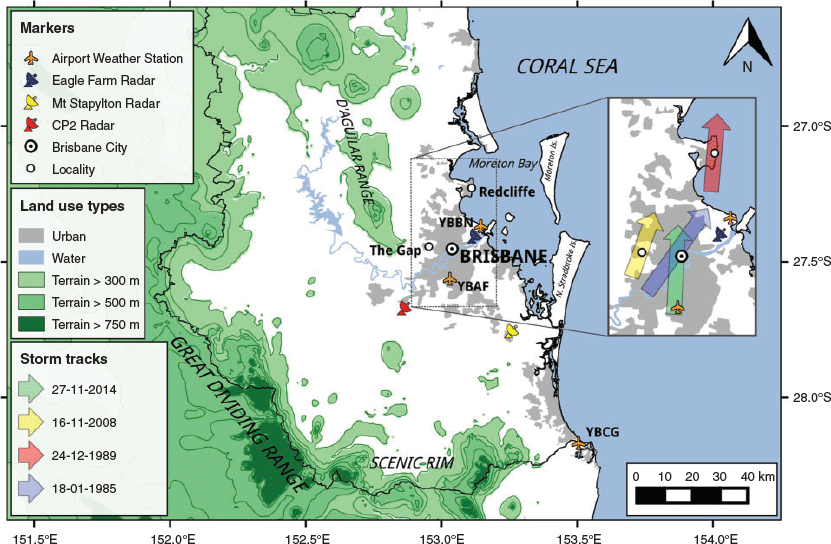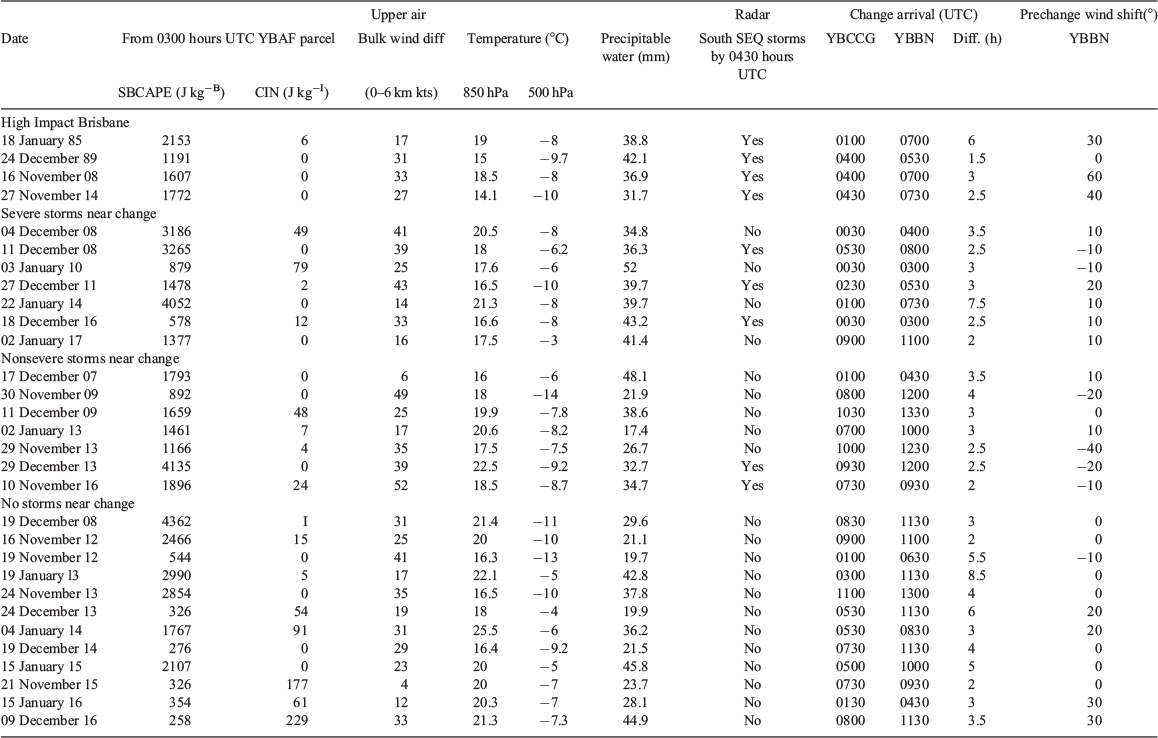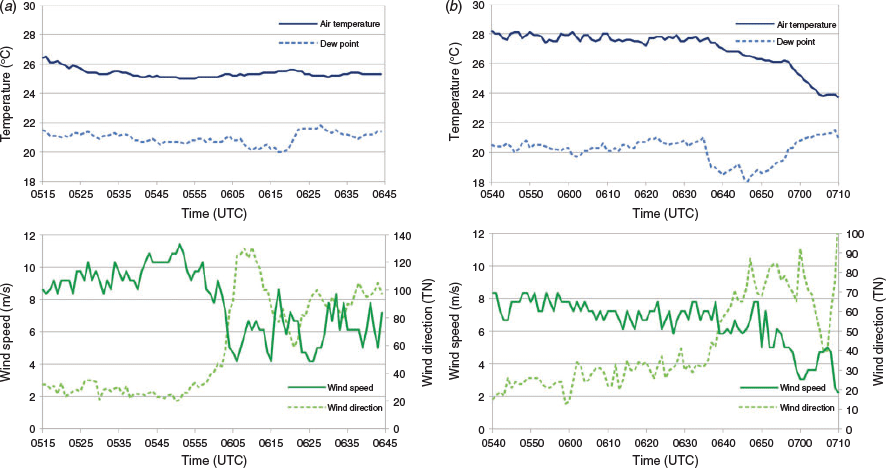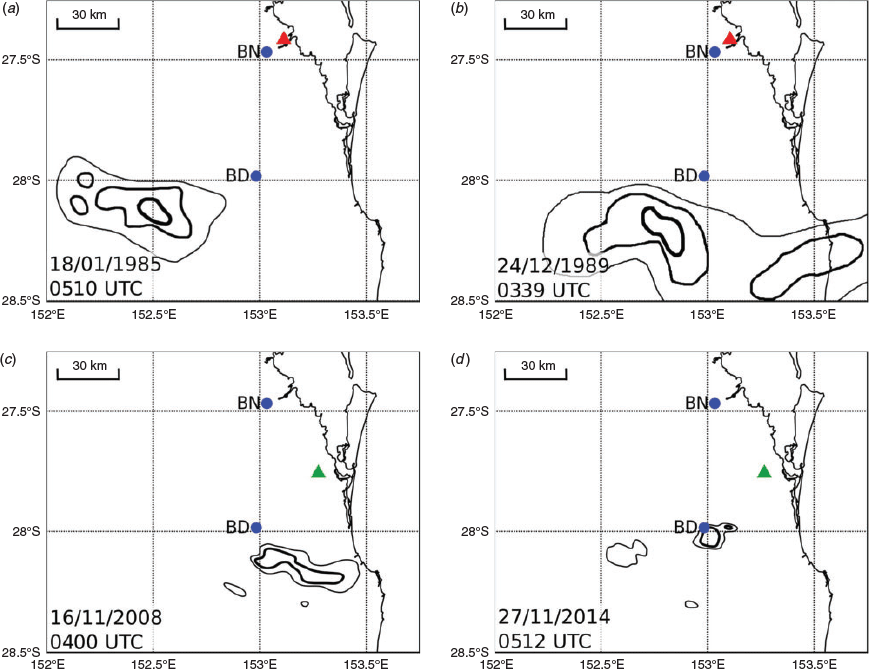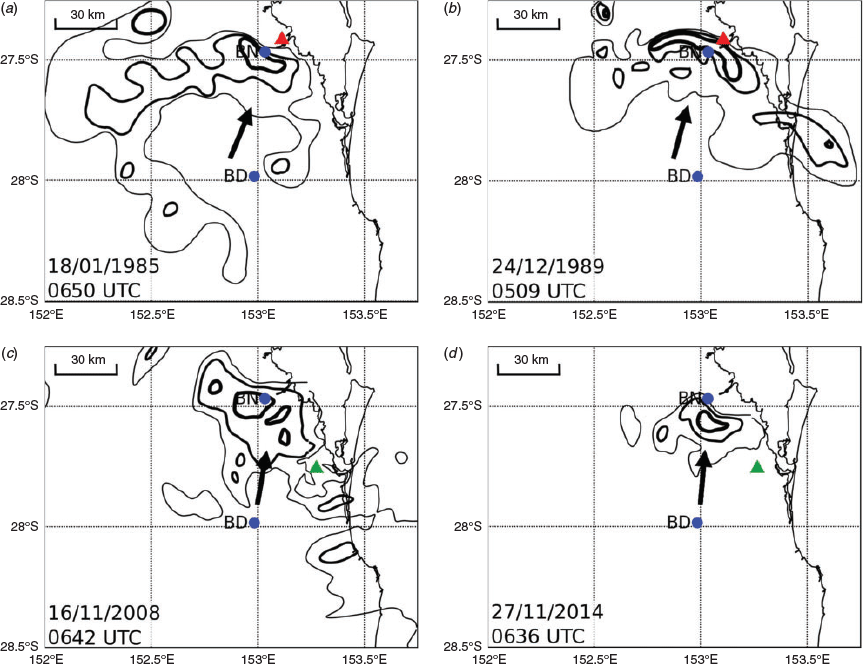High-impact thunderstorms of the Brisbane metropolitan area
Joshua S. Soderholm A B , Kathryn I. Turner B , Jordan P. Brook B , Tony Wedd C and Jeffery Callaghan CA Australian Bureau of Meteorology, GPO Box 1289, Melbourne, Vic. 3001, Australia.
B The University of Queensland, St Lucia, Qld., Australia.
C Australian Bureau of Meteorology, Brisbane, Qld., Australia.
D Corresponding author. Email: joshua.soderholm@bom.gov.au
Journal of Southern Hemisphere Earth Systems Science 69(1) 239-251 https://doi.org/10.1071/ES19017
Submitted: 28 May 2019 Accepted: 8 November 2019 Published: 11 June 2020
Journal Compilation © BoM 2019 Open Access CC BY-NC-ND
Abstract
Accurate thunderstorm warnings in the hours-to-minutes preceding impact are often limited by the complex evolution of the mesoscale atmospheric environment. To accurately capture these complexities, analysis of observations remained central to operational short-term nowcasting predictions of thunderstorms. Over the past 40 years, multiple high-impact thunderstorm events have impacted the Brisbane Metropolitan Area (BMA) of South East Queensland resulting in significant insured losses. Four of these high-impact events were the focus of the following work. These cases included three events that resulted in the greatest insured losses for the BMA, exceeding AU$4 billion (2017) (18 January 1985, 16 November 2008 and 27 November 2014) and a fourth significant event (24 December 1989). Synthesis of previous work indicates that the four high-impact cases occurred during a south-easterly change with strengthening winds ahead of the change, suggesting commonalities may exist that can be exploited for forecasting. This paper provides a detailed observational analysis of the environment and convective storms from the four BMA events to explore discriminating characteristics that may improve the skill of nowcasting. For the four BMA events, significant deep convection was observed along the change for the hours prior to the change’s arrival at the Brisbane Airport, potentially acting as an early indicator of favourable conditions for high-impact thunderstorms. It was found that the timing of the south-easterly change through Brisbane was also highly correlated for all events, occurring within a 90-min window during the mid-afternoon convective heating maximum. Despite the destructive severe weather, upper air conditions were marginal for supporting organised thunderstorms, highlighting the importance of capturing mesoscale processes, such as the south-easterly change. To further understand possible discriminators of the four high-impact BMA cases, a 10-year climatology of the mesoscale and synoptic environment associated with south-easterly change events was developed for the warm season months of November to January. It is shown that although only a small number of events are associated with high-impact BMA thunderstorms, these events share a set of conditions relating to the prechange wind shift, timing of the south-easterly change and radar signatures.
1 Introduction
The impact of thunderstorms upon the Brisbane Metropolitan Area (BMA) and the encompassing South East Queensland (SEQ) region of Australia is recognised through both climatological (Allen and Karoly 2014; Peter et al. 2015; Soderholm et al. 2017a; Allen and Allen 2016) and event-based studies (Richter et al. 2014; Soderholm et al. 2016, 2017b). Although most thunderstorms have a limited impact on the BMA, the region experiences more reports of large hail (>2 cm) and damaging wind gusts (>25 m s−1) than any other Australian capital city (Allen and Karoly 2014). Furthermore, a small number of these severe events have resulted in catastrophic losses for densely populated suburbs of the BMA, leaving a lasting impression upon the public (e.g. The Gap windstorm, Richter et al. 2014). Distinguishing the environments which support potentially catastrophic thunderstorms from numerous lower impact storms remains a challenge for forecasters. One potential discriminator is the south-easterly change synoptic type, which Soderholm et al. (2017b) showed is associated with significantly more severe thunderstorm days than other synoptic conditions. Furthermore, the south-easterly change type is associated with the four events that are the focus of this study: the 18 January 1985 Brisbane hailstorm, the 24 December 1989 Redcliffe peninsula tornadic storm, the 16 November 2008 windstorm at The Gap and the 27 November 2014 Brisbane hailstorm. Understanding the conditions which favour these destructive thunderstorms during a south-easterly change is essential for improving the prediction of future events in the BMA.
The climate of SEQ is characterised by a warm coastal subtropical regime, with prevailing easterly trade winds and local sea breezes. The occasional passage of dry continental or tropical air masses supports a variable synoptic environment during the austral spring and summer. Thunderstorm environments are often characterised by high instability and marginal deep layer (0–6 km) bulk wind difference, limiting the potential for long-lived organised convection that is typically associated with destructive impacts (Peter et al. 2015). The physical setting is characterised by undisturbed-forested mountain ranges (800–1200 m) bordering the southern and western regions of SEQ, providing an initiation mechanism for convective storms (Fig. 1). The adjacent coastal plains are extensively modified for agriculture and urbanisation (including the city of Brisbane). During spring and summer, sea breezes develop across these coastal plains on 8–14 days per month (Soderholm et al. 2017b). Increased low-level shear and moisture associated with the sea-breeze air mass potentially favours the intensification of some thunderstorm events (e.g. Soderholm et al. 2017b), while weakening others (e.g. Soderholm et al. 2016). The passage of air mass boundaries through the region also provides the much-needed low-level shear to support thunderstorm organisation in the typically weak wind shear conditions of a subtropical climate (e.g. Sills et al. 2004). Furthermore, Callaghan (1996) noted that high-impact severe thunderstorm events in SEQ are often associated with the passage of a south-easterly change boundary.
South-easterly air mass changes in SEQ are forced by a developing coastal ridge which generally propagates behind a boundary causing cooler air to be channelled northward along the eastern slopes of the Great Dividing Range. Previous studies focusing on the south-easterly change of the SEQ region are absent; however, numerous studies have documented a similar phenomenon, known colloquially in New South Wales (NSW) as the southerly buster. Pertinent characteristics include the northward moving cold air mass, terrain channelling and rapid drop in temperature with a positive pressure gradient. A key difference to the south-easterly change, documented by numerous studies (Colquhoun et al. 1985; Holland and Leslie 1986; Howells and Kuo 1988), lies in the deformation of the front. The southerly buster has been shown to coincide with the deformation of a cold front moving over the Australian Alps Baines (1980) (Holland and Leslie 1986; Howells and Kuo 1988). By the time the cold front has reached the central coast of NSW, its frontogenic nature has weakened significantly, resulting in a slower propagation and a weaker thermal gradient. The extent that the modified air mass interacts with the land and relatively warm (>20°C) coastal sea as it propagates across SEQ is unknown, as is the influence upon the convective environment. The following paper provides an analysis of the four BMA high-impact events and comparison against a 10-year climatology of south-easterly changes. These comparisons provide the basis of a discussion of potential discriminators that aim to assist the identification of future high-impact thunderstorms in the BMA.
2 Event summary and impacts
The severe thunderstorm events of 18 January 1985, 24 December 1989, 16 November 2008 and 27 November 2014 resulted in significant losses to SEQ and a lasting community awareness. Insured losses from 1985 event are the second highest recorded in Australia (after the 1999 Sydney hailstorm) and the highest for the BMA, with a total of AU$2.27 billion (2017 value; Insurance Council of Australia 2017). Damage extended from the south-western suburbs of the BMA to Brisbane Airport (YBBN) in the north-east, with a damage area width of 8–12 km (Fig. 1, Callaghan 1996). A wind gust of 40 m s−1 (78 kn) was reported at the Brisbane City weather station and the 51 m s−1 (101 kn) wind gust at YBBN remains the highest recorded for the SEQ region. Roof damage was reported to over 20 000 houses, with 2000 homes unroofed and 12 declared structurally unsafe (Fig. 2a, Johnstone 1985). The event impacted Brisbane during peak hour (0700 hours UTC; local time = UTC + 10 h) on a weekday (Friday), increasing motor vehicle exposure to hailstones as large as tennis ball size (>65 mm, Johnstone 1985).
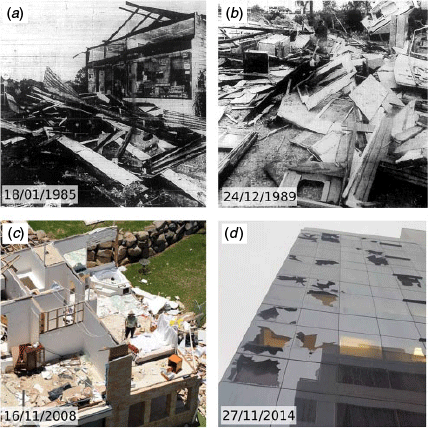
|
The 1989 Christmas Eve event impacted the northern bayside suburbs of the BMA primarily through tornado damage, resulting in several injuries and two deaths (Fig. 1, Southorn 1989). Nearly 1000 homes were damaged with ~500 unroofed and extensive damage to the Redcliffe marina (Fig. 2b). The cell tracked north along the Queensland coastline for over 4 h resulting in AU$11.8 million (1990 value; Insurance Council of Australia 1990, personal communication, 9 July) of insured losses. Ignoring changes to residential buildings and contents, the consumer price index provides an estimated 2017 value of AU$24.5 million for insured losses.
On the 16 November 2008, a destructive wet microburst impacted the north-western suburbs of the BMA, in particular the suburb of The Gap. Radial wind velocities exceeding 43 m s−1 (84 kn) were observed by the Doppler radar, in addition to reports of 40-mm hailstones (Leitch et al. 2009; Richter et al. 2014). Damage was reported to 1300 houses, 262 of which were declared structurally unsafe (Fig. 2c, O’Brien 2009). Fortunately the event occurred on a Sunday afternoon, limiting the exposure of motor vehicles. Insured losses from the event exceeded AU$224 million (2017 value; Insurance Council of Australia 2017, B Buckley 2018, personal communication, 28 March).
The most recent high-end event to impact the BMA occurred on Thursday the 27 November 2014, damaging an area extending from the south-western to the north-eastern suburbs. A wind gust of 39 m s−1 (76 kn) was observed by the Archerfield Airport (YBAF) surface station and giant 70 mm hailstones were observed in the CBD, creating widespread roof and motor vehicle damage (Fig. 2d, Parackal et al. 2015). The time of day (0600 hours UTC) contributed to significant motor vehicle damage, with a total insured loss of AU$1.54 billion (2017 value; Insurance Council of Australia 2017).
3 Synoptic and mesoscale environment
Surface and upper air synoptic analyses at 0000 hours UTC (1000 hours local time) were generated for each event using the ERA-Interim reanalysis (Fig. 3, Dee et al. 2011). To diagnose cloud characteristics, infrared (10.2–11.2 μm) satellite imagery for three different platforms (GMS-3, GMS-4 and MTSAT-1R) was sourced from the International Satellite Cloud Climatology Project (ISCCP) around 2330 hours UTC (Fig. 4, Knapp 2008). For all four events, a broad trough associated with the dryline and upper level ridge (board region of warm 500-hPa temperature) is present across northern Australia (Fig. 3), maintaining clear conditions across SEQ on the morning of each event (Fig. 4). A developing surface ridge along the south-eastern coast of Australia is also present, extending from a high-pressure region in the Great Australian Bight. Upper level temperature (500 hPa) over south-eastern Australia indicates the presence of a negatively tilted trough over the Tasman Sea. For the 2008 event, a vertically stacked low remains closer to the Australian coastline and a cloud band from the associated cold front is evident in satellite imagery. Conditions over SEQ were not indicative of high-end severe thunderstorm environments given the absence of notable surface and upper level troughing, with 500 hPa temperatures between −8 and −10°C (Table 1). Cloud along the northern and eastern edge of the south-easterly air mass can also been seen offshore of NSW for each event and a postfrontal cloud field further south associated with the high-pressure region.
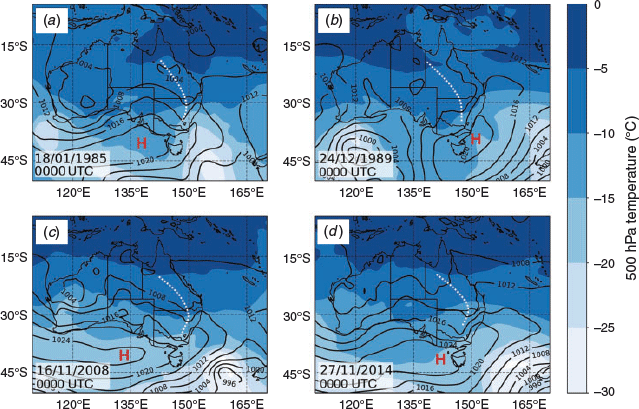
|
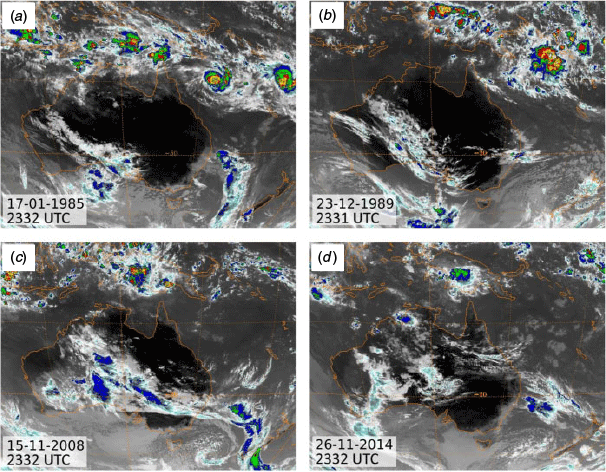
|
To further analyse the prestorm environments of each case, morning (2300 hours UTC) upper air soundings from Brisbane Airport (YBBN) were processed using the Sharppy package (Fig. 5, Blumberg et al. 2017). The surface parcel from the morning soundings was modified to the 0300 hours UTC Archerfield Airport (YBAF) weather station observation (Fig. 1) to better represent the prestorm conditions further inland. Virtual temperature correction was applied for calculation of parcel-based parameters (Doswell and Rasmussen 1994). Lifted surface parcels were found to be uncapped, with the exception of the 1985 event which had 6 J kg−1 of Convective Inhibition. Surface-based convective available potential energy (SBCAPE) were moderate to high for deep convection, ranging from 1191 J kg−1 for the 1989 event to 2153 J kg−1 for the 1985 event. Precipitable water calculated from the sounding ranged between 29.2 mm for 1985 and 42.1 mm for 1989. Furthermore, dry-air layers were largely absent from the 1989 and 2008 profiles, suggesting that thunderstorms updrafts would remain relatively free of dry-air entrainment. All profiles exhibit light winds (<5 m s−1 and <10 kn) below 3 km, with north-west to north-easterly winds at the surface ahead of the change. Above 3 km, winds backed from the west to southwest with a gradual increase in speed to >26 m s−1 (50 kn) at 9 km, with the exception of the 1989 case, where winds increased to 18 m s−1 (35 kn) at 4 km. Bulk wind difference between 0 and 6 km were as a result marginal, ranging between 8.7 m s−1 (17 kn) for the 1985 event and 17 m s−1 (33 kn) for the 1989 event. Prior to additional low-level shear generated by the south-easterly change, the high instability weak shear environments observed in sounding profiles would have indicated to forecasters that highly organised thunderstorms were unlikely (Weisman and Klemp 1982).
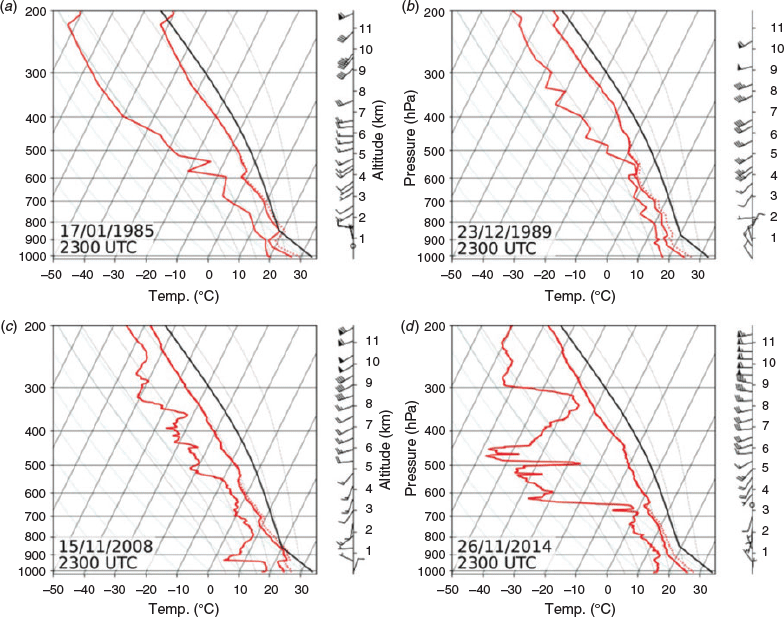
|
To diagnose the afternoon convective potential and the spatial variability of the near-surface environment, meso-analyses of SEQ were prepared using 0500 hours UTC weather station observations. These are shown in Fig. 6 (Koch and Ray 1997). For each event, the south-easterly change can be identified as a zonal air mass boundary with south-easterly winds between 5 and 8 m s−1 (10–15 kn) to the south of the boundary. The wind speeds associated with the change are weaker than those documented for southerly busters (e.g. >15 m s−1, Colquhoun et al. 1985). For all events, the change arrived in Brisbane during the late afternoon, coinciding with peak diurnal heating, whereby surface parcels approach maximum instability (Table 1). North of the south-easterly change, a meridionally aligned wind shift boundary can be seen. For the 1985, 2008 and 2014 cases, this boundary likely relates to the effects of the Great Dividing Range, with westerly momentum mixed to the surface of the elevated terrain and north-easterlies extending to the foothills of the range (Fig. 1). Sea breezes are common in SEQ during warmer months and advect a north-easterly maritime air mass over the region (Soderholm et al. 2016). For the 1989 case, the drier continental air found in the north-western SEQ was replaced with a very humid air mass under large scale northerly to north-easterly flow (Fig. 3b). In comparison to the other three cases, coastal wind speeds for 1989 were less, suggesting a weaker sea breeze was present. This is likely the result of morning cloud cover, evident in both the satellite imagery (Fig. 4b) and the 2300 hours UTC sounding profile as a saturated layer at 550 hPa (Fig. 5b), inhibiting diurnal heating and large scale north-easterly flow further weakening the land-sea temperature gradient.
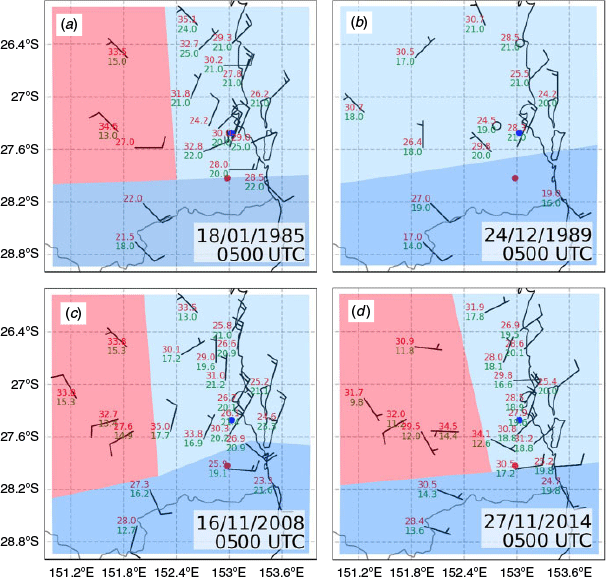
|
Ongoing evolution of the prestorm environment must be expected in the hours preceding storm impact due to strong diurnal heating, the sea-breeze circulation and the approaching south-easterly change. Only the 1989 change arrived at YBBN shortly after the 0500 hours UTC observation, whereas the change for the 1985, 2008 and 2014 events arrived more than 1.5 h later. For the 1985 case, the highest temporal resolution of YBBN surface observations available is at a 30-min interval. The last YBBN observation before storm arrival and, therefore, the most representative of prestorm environment was at 0630 hours UTC. Surface temperature had cooled by 3°C (now 28°C) since 0500 hours UTC, likely due to increasing altocumulus coverage noted by the YBBN observer. Dew point temperature remained steady (less than 1°C drop) over this period. During the same period, YBBN surface winds veered from 30 to 60° TN and increased from 11 to 15 kn. Inflow parcels for the severe thunderstorms originated from this easterly air mass as it approached the BMA, opposed to the sea-breeze air mass observed at 0500 hours UTC. Even with the reduced buoyancy from a cooler prestorm environment, the increased storm-relative flow would have been more favourable for organisation (Coniglio et al. 2011). Thirty-minute YBBN surface observations for the 1989 event show a comparable cooling (3°C) and strengthening of prechange flow (by 5 kt), but no change in direction (30° TN) between the 0330 hours UTC and 0500 hours UTC observations.
For the 2008 and 2014 cases, 1-min observations from YBBN are shown in Fig. 7 for the 90-min period prior to the arrival of the south-easterly change. The higher temporal sampling resolves significantly more variability than the 30-min observations from the 1985 and 1989 events, including an easterly wind shift of greater magnitude to the 1985 event (80 and 60° shift c.f. 30°). Cooling of a similar magnitude to the 1985 event (4°C) occurred for the 2014 event, but not the 2008 event. Furthermore, in contrast to the 1985 event, surface wind speed weakened (>4 kn decrease) for both 2008 and 2014 cases. Both the temperature (2014) and wind shift (2008 and 2014) occurred concurrently within 30–40 min window prior to the arrival of the change. This correlation suggests that the cooling for the 2014 case, and possibly the 1985 case, was in response to a change in onshore flow characteristics rather than cooling from increasing cloud coverage. These changes on timescales of tens of minutes are poorly sampled by the 30-min observations; therefore, it is impossible to rule out similar processes occurring prior to the 1985 and 1989 BMA storms.
Richter et al. (2014) and Soderholm et al. (2017a) show the respective 2008 and 2014 BMA storms that were surface-based at the time of impact and that inflow parcels were mostly sourced from the onshore flow ahead of the change. YBBN observations have shown that surface parcels were becoming less buoyant in the tens of minutes prior to the change; however, elevated parcels may have remained more favourable. Analysis of profile data from the afternoon of the 2008 and 2014 cases by Richter et al. (2014) and Soderholm et al. (2017a) captured the evolution of elevated air masses. For upper levels (<700 hPa), the temperature and shear profile remained very similar to the 0000Z sounding. Within the boundary layer, both case studies noted a deep, well-mixed layer above the sea-breeze circulation. Soderholm et al. (2017a) attributed this layer to the advection of the continental boundary layer eastwards over the coastal plains. Richter et al. (2014) suggested that the drier layer could have contributed to the destructive surface winds by enhancing the cold-pool intensity through stronger evapourative cooling. Without afternoon profile data for the 1985 and 1989 events, the contribution of elevated air masses remains unknown.
4 Radar comparison
Significant changes to weather radar technology and data over the 29 years between the 1985 and 2014 cases requires careful consideration when comparing the four case study events. For the 1985 event, only Terminal Area Severe Turbulence (TAST) radar tracings are available from the BoM Eagle Farm weather surveillance radar (Fig. 1). These tracings were collected by manually tracing radar scans from a cathode-ray tube display at three reflectivity levels (30, 40 and 50 dBZ) from the 0.5° plan position indicator (PPI) scan. For the 1989 event, printouts of digital radar imagery from the Eagle Farm radar are available, providing six reflectivity levels (15, 30, 40, 45, 50 and 55 dBZ) from the 0.5° PPI scan. The TAST tracings and imagery printouts were georeferenced and digitised using the QGIS software package and plotted using the Cartopy package. For the 2008 and 2014 events, digital radar data was sourced from the Brisbane Mt Stapylton Doppler weather radar. The Py-ART software package was used to process the 0.5° PPI imagery (Helmus and Collis 2016). Data were smoothed using a Gaussian filter (σ = 4.0) and contoured at the TAST levels (30, 40 and 50 dBZ) to replicate the style of the 1985 TAST tracing (Figs 8 and 9).
The radar scans shown in Fig. 8 represent the first detection of reflectivities exceeding 50 dBZ for each case within the SEQ region. For all cases, the antecedent deep convection occurred within the southern Scenic Rim region of SEQ (Fig. 1), likely forced by the colocated south-easterly change interacting with the mountainous terrain (Fig. 6). The 1985 and 1989 storms exhibited larger areas of high reflectivity (>50 dBZ) in contrast to the 2008 and 2014 events. This area difference is partly due to the larger sampling volume of the Eagle Farm radar beam (3°) at increasing range in comparison to Mt Stapylton (0.9° beamwidth). Miscalibration of the Eagle Farm radar may have also increased the size of the high reflectivity areas. Regardless, these high reflectivity regions are associated with reports of widespread damage through southern and south-western areas of SEQ, confirming that severe storms were present well before impact on the BMA (Johnstone 1985; Southorn 1989). The discrete nature of the high reflectivity regions and damage reports plausibly suggests a high-end multicell or supercell storm mode; however, any analysis of the nebulous radar imagery remains highly subjective.
For all cases except 1989, the severe thunderstorms which impacted the BMA initiated ahead of the antecedent convection shown in Fig. 8. Regardless, all four cases traversed the BMA with a north-northeast heading (Fig. 1) and exhibited large areas of reflectivity exceeding 50 dBZ (Fig. 9). A tight reflectivity gradient with a notch along the leading edge for the 1985 and 2014 storms suggests a mesocyclone was present within a parent supercell storm. Supercells are known for producing a disproportionate amount of large hail and tornadic events (Moller et al. 1994; Smith et al. 2012). The 1989 case exhibits a distinct quasi-linear convective system (QLCS) mode by 0509 hours UTC over Brisbane, indicating a transition from the possible discrete mode observed at 0339 hours UTC (Trapp et al. 2005). Furthermore, notches along the rear of the QLCS are possible indicators of descending mid-level flow and damaging straight-line winds at the surface (Klimowski 1994; Skamarock et al. 1994). A tornado was reported along the leading edge of the 1989 storm at 0545 hours UTC, impacting the Redcliffe peninsula area, possibly generated by a QLCS mesocyclone (Australian Bureau of Meteorology 1989). Transient tornadoes associated with QLCS, in particular those with bow echoes, have been documented in numerous cases (e.g. Trapp et al. 2005; Skow and Cogil 2017). Unfortunately an outage of the Eagle Farm weather radar occurred shortly after the storm impacted the CBD, and no imagery was collected at the time of the tornado event to further understand the characteristics of the parent storm.
In contrast, the 2008 storm exhibited an unorganised structure, lacking the tight reflectivity gradients observed during the other events. Detailed analysis by Richter et al. (2014) documents a high-end multicell mode where destructive winds were likely the result of acceleration into a low-level mesocyclone. Remarkably, the 1985, 2008 and 2014 severe storms (and associated south-easterly change) arrived at Brisbane Airport (YBBN) within a 60-min window (630–0730 hours UTC). The 1989 QLCS event occurred earlier, at 0510 hours UTC. This narrow window suggests that time of arrival is an important factor for high-impact storms in the BMA; however, further analysis is required in the context of a long-term climatology data set.
5 Climatological context
The environmental and radar analysis have provided a number of shared characteristics between the four BMA events, in particular the 1985, 2008 and 2014 events. The 1989 case differs due to the earlier arrival time of the south-easterly change and the linear convective mode but shares comparable conditions prechange, including a warm maritime air mass and mid-afternoon thunderstorm activity over southern SEQ. In summary, these characteristics include
Upper air: Modest environmental support for organised convection (all cases)
Radar: Mid-afternoon thunderstorm activity over southern SEQ region (all cases)
Surface: Veering of prechange onshore flow from the north-east to east just prior to change arrival (excludes 1989)
Timing: Thunderstorm arrival at BMA between 0630 and 0730 hours UTC (excludes 1989)
To explore whether these characteristics and others discriminate the 1985, 1989, 2008 and 2014 BMA events from thunderstorms with limited or no impact, a climatological analysis was conducted. Given the south-easterly change was the dominant synoptic feature for all four cases, a 10-year (2007–17) climatology of south-easterly change events for SEQ was compiled through the examination of 30-min surface observations, 2300 hours UTC radiosonde profiles, and radar observations held by the Australian Bureau of Meteorology. Only changes occurring in November, December or January were considered, as these months are considered to be the peak of the storm season (Soderholm et al. 2017b) and include all four BMA events. Candidate south-easterly change days were identified as a wind shift between 2300 and 1100 hours UTC using the following criteria:
2300 hours UTC (0900 AEST) 10-min mean wind direction at Coolangatta Airport (YBGC, Fig. 1) from west-northwest through to east-northeast inclusive (337.5–67.5°).
1100 hours UTC (2100 AEST) 10-min mean wind direction at YBGC between southeast to south inclusive (90° to 180°) with a minimum 10-min mean wind speed of 4.1 m s−1 (8 kn).
Thirty south-easterly change events were identified using the criteria above and are presented in Table 1 with respective parameters relating to the upper air and surface conditions. Events are grouped according the amount and intensity of thunderstorm activity occurring with the change. Despite the small sample size, this data set provides valuable insight into the environmental conditions that support thunderstorms during south-easterly changes. The strongest discriminator between the four BMA events and other days was found to be the timing of the south-easterly change across SEQ. For the southern YBGC station, the arrival of the change is clustered between 0400 and 0430 hours UTC for three of the four cases, with the 1985 event an outlier due to the earlier arrival time of 0100 hours UTC. At YBBN, only for two other events did the south-easterly change arrive within the 0530 and 0730 hours UTC window of the four BMA events. Excluding the 1989 event contracts this window to a 60-min period between 0630 and 0730 hours UTC, for which only one other event occurred (22 January 2014) and was also associated with severe storms outside of SEQ. This mid-afternoon period is generally associated with a peak in severe thunderstorm activity due to the convective heating maximum (e.g. Allen and Allen 2016), indicating that the passage of a south-easterly change at this time realises the most diurnally favourable environment for convective storms.
Within the prechange environment, the three of the four BMA cases (1985, 2008 and 2014) exhibited a distinct wind-shift of at least 30° from the north-east to east (veering) during the hour prior to the change. The prechange wind shift is also computed for the climatology events in Table 1. Across the climatology, only two events meet this criterion but occurred on days where no storms were near the change. Prechange wind speed (3-h mean prior to change) was found to be more variable, with many of the climatology cases exceeding the modest wind speeds of the 1985 and 2014 BMA cases (not shown). The average prechange wind-shift threshold of 30° is, therefore, the most useful discriminator.
Despite their widespread use, instability and wind shear parameters derived from the morning (2300 hours UTC) radiosonde profile were found to have little relation to thunderstorm activity during south-easterly changes. Table 1 shows the SBCAPE calculated from the morning profile using a parcel initialised using the 0300 hours UTC (afternoon) observation from the Archerfield airport site (YBAF, Fig. 1). The YBAF site samples the prestorm environment immediately south of the BMA, along the expected storm track. Although moderate-to-high SBCAPE was observed for the BMA cases (ranging between 1191 and 2153 J kg−1), they do not represent the most unstable environments in the climatology. In total eight other events (26%) in the climatology exhibited larger SBCAPE (over 4000 J kg−1 in some cases) but with negligible thunderstorm impact. The poor correlation between instability and thunderstorm activity is likely influenced by the use of morning soundings to represent an evolving afternoon environment 5–6 h later, despite adjusts made using an afternoon surface parcel. The bulk wind difference between the surface to 6 km observed for the BMA cases were generally only moderate to marginally high, ranging from 8.7 to 17 m s−1 (17–33 kn). These values were equalled or exceeded by 36 % (11) events in the climatology, including four cases that exceeded the BMA events in both buoyancy and bulk wind difference.
Mid-afternoon (0500 hours UTC) thunderstorms were observed over southern SEQ in proximity to the arriving change for all BMA cases (Fig. 8), suggesting this signature is a potential precursor. Analysis of the climatology events shows that this signature occurred for 5 of the 14 other south-easterly change events with thunderstorms, supporting the use of this precursor. Examination of various thermodynamic parameters showed that certain thresholds of moisture and instability are also useful for separating the BMA cases. In particular, based on the 2300 hours UTC radiosonde flight from YBBN, precipitable water of ≥30 mm (excludes 30% (9) cases in Table 1) and a 500-hPa temperature of ≤−8°C (excludes 43% (13) cases in Table 1) were found to be necessary (but not sufficient) thresholds. The observed thermodynamic profile for the BMA events was characterised by a generally moist environment up to a height of ~650 hPa, with no large (greater than 100 hPa in depth) dry slots below this level. The 850-hPa temperature did not exceed 19°C for any of the four case study events (cooler than 43% (13) other cases). A well-mixed boundary layer and buoyant surface parcels provided zero or near-zero convective inhibition for all the BMA cases in contrast to a 40% (12) other cases with greater capping.
In combination with the prestorm radar analysis, the 10-year south-easterly change climatology yields five important, but not sufficient, discriminators of high-impact events (Table 2). Caution must be used when applying these discriminators to future events due to the small sample size; however, these discriminators do provide useful insight into characteristics of the prestorm environment, some of which are typically not considered in operational forecasting.

|
6 Summary
Accurate prediction of high-impact thunderstorms remains a significant challenge for the BMA against a climatology of predominantly marginal events. Analysis of four high-impact events in the BMA, which included the three highest impact events in the past 30 years, shows the south-easterly change synoptic type was associated with each case. Commonly applied upper air diagnostics for thunderstorms, including SBCAPE and bulk wind difference, are poor discriminators for the severity for the four BMA cases, promoting further investigation at the mesoscale. The presence of the south-easterly change boundary was evidently critical for storm evolution, in particular, the arrival timing at the BMA during the mid-afternoon. Radar imagery shows deep convection along the south-easterly change for all four BMA cases by mid-afternoon (0500 hours UTC). The convective mode at time of the BMA impact was variable. Lower quality imagery from the Eagle Farm suggests a supercell and QLCS modes for the 1985 and 1989 events respectively. The modern Mt Stapylton radar clearly shows a high-end multicell and supercell for the 2008 and 2014 events respectively.
To identify discriminators for high-impact BMA cases from other south-easterly change events (some of which produced no thunderstorms), a climatology of south-easterly change events over the last 10 years (November to January 2007–17) was developed (Table 1). Five criteria were established to be important, but not sufficient, for high-impact thunderstorm for the BMA. First, the timing of the change boundary at YBCG (0100–0430 hours UTC) followed by arrival at YBBN (0530–0730 hours UTC) was shown to be an important discriminator, in addition to the presence of deep convection on the change by ~0430 hours UTC. Wind direction shift ahead of the south-easterly change also proved to be a useful indicator, raising further questions about the properties of this air mass. From the morning (2300 hours UTC) Brisbane Airport (YBBN) sounding, precipitable water and 500-hPa temperatures were also found to be useful for distinguishing the four high-impact events. Application of these criteria provides forecasters with an additional decision-making tool for identifying possible high-impact south-easterly change events in the days and hours leading up to impact on the BMA.
Soderholm et al. (2017b) and Richter et al. (2014) showed that inflow parcels for the respective 2014 and 2008 BMA cases originated from the onshore flow in the boundary layer. Further, this study has shown that onshore flow characteristics changed significantly within 1 h of the 2008 and 2014 storm events. Quantifying the origin, buoyancy and shear of this new air mass is required to understand its convective potential, likely leading to the refinement of criteria in Table 2. This understanding will benefit forecasting in thunderstorm prone coastal settings outside of SEQ which also experience similar south-easterly changes, including the Sydney region and NSW coast. The diversity of south-easterly changes identified through the climatological analysis merits further expansion to increase the sample size. This will assist with refining the discriminating criteria of high-impact storm events and possibly suggest a relationship with multiyear climate cycles. Further study of south-easterly changes using high-resolution model data sets (e.g. Bureau of Meteorology Atmospheric high-resolution Regional Reanalysis for Australia) and evaluation through field experiments is encouraged by the authors given the role of this synoptic type for high-impact thunderstorm events in SEQ.
Acknowledgements
The authors express their gratitude for Tamika Tihema from the Brisbane office of the Bureau of Meteorology for support developing the climatological analysis. Extraction of historical newspaper articles for the 1985 and 1989 cases was provided by Margretha Gould from the State Library of Queensland. Assistance for calculating normalised insured losses was provided by Bruce Buckley from Insurance Australia Group. The authors wish to thank the forecasters of the Queensland office for their insightful discussions towards this paper, in particular Dean Narramore, Andrew Bufalino and David Grant, and Anthony Cornelius from WeatherWatch. Finally, the authors wish to thank Harald Richter and two anonymous reviewers for the valuable input towards improving this study. This research did not receive any specific funding.
References
Allen, J., and Karoly, D. (2014). A climatology of Australian severe thunderstorm environments 1979-2011: inter-annual variability and ENSO influence. Int. J. Climatol. 34, 81–97.| A climatology of Australian severe thunderstorm environments 1979-2011: inter-annual variability and ENSO influence.Crossref | GoogleScholarGoogle Scholar |
Allen, J. T., and Allen, E. R. (2016). A review of severe thunderstorms in Australia. Atmos. Res. 178–179, 347–366.
| A review of severe thunderstorms in Australia.Crossref | GoogleScholarGoogle Scholar |
Australian Bureau of Meteorology (1989). Severe Weather Summary Terminal No. 18 IDA10Q. Tech. Rep. (Australian Bureau of Meteorology: Brisbane, Qld., Australia.)
Baines, P. G. (1980). The dynamics of the Southerly Buster. Austr. Meteorol. Mag. 28, 175–200.
Blumberg, W. G., Halbert, K. T., Supinie, T. A., Marsh, P. T., Thompson, R. L., and Hart, J. A. (2017). Sharppy: An open-source sounding analysis toolkit for the atmospheric sciences. Bull. Am. Meteorol. Soc. 98, 1625–1636.
| Sharppy: An open-source sounding analysis toolkit for the atmospheric sciences.Crossref | GoogleScholarGoogle Scholar |
Callaghan, J. (1996). Review of severe thunderstorm forecasting and the severe thunderstorm warning service in the southeast coast district of Queensland. In 5th Australian Severe Thunderstorm Conference. Australian Bureau of Meteorology, Avoca Beach, New South Wales, p. 178.
Colquhoun, J. R., Shepherd, D. J., Coulman, C. E., Smith, R. K., and McInnes, K. (1985). The Southerly Buster of South Eastern Australia: An Orographically Forced Cold Front. Mon. Wea. Rev. 113, 2090–2107
Coniglio, M. C., Corfidi, S. F., and Kain, J. S. (2011). Environment and early evolution of the 8 May 2009 derecho-producing convective system. Mon. Wea. Rev. 139, 1083–1102.
| Environment and early evolution of the 8 May 2009 derecho-producing convective system.Crossref | GoogleScholarGoogle Scholar |
Dee, D. P., Uppala, S. M., Simmons, A. J., Berrisford, P., Poli, P., Kobayashi, S., Andrae, U., Balmaseda, M. A., Balsamo, G., Bauer, P., Bechtold, P., Beljaars, A. C. M., van de Berg, L., Bidlot, J., Bormann, N., Delsol, C., Dragani, R., Fuentes, M., Geer, A. J., Haimberger, L., Healy, S. B., Hersbach, H., Hólm, E. V., Isaksen, L., Kållberg, P., Köhler, M., Matricardi, M., McNally, A. P., Monge-Sanz, B. M., Morcrette, J. J., Park, B. K., Peubey, C., de Rosnay, P., Tavolato, C., Thépaut, J. N., and Vitart, F. (2011). The ERA-Interim reanalysis: configuration and performance of the data assimilation system. Q. J. R. Meteorol. Soc. 137, 553–597.
| The ERA-Interim reanalysis: configuration and performance of the data assimilation system.Crossref | GoogleScholarGoogle Scholar |
Doswell, C. A., and Rasmussen, E. N. (1994). The effect of neglecting the virtual temperature correction on CAPE calculations. Wea. Forecasting 9, 625–629.
| The effect of neglecting the virtual temperature correction on CAPE calculations.Crossref | GoogleScholarGoogle Scholar |
Helmus, J. J., and Collis, S. M. (2016). The python ARM radar toolkit (Py-ART), a library for working with weather radar data in the python programming language. J. Open Res. Soft. 4, e25.
| The python ARM radar toolkit (Py-ART), a library for working with weather radar data in the python programming language.Crossref | GoogleScholarGoogle Scholar |
Holland, G. J., and Leslie, L. M. (1986). Ducted coastal ridging over S.E. Australia. Q. J. R. Meteorol. Soc. 112, 731–748.
| Ducted coastal ridging over S.E. Australia.Crossref | GoogleScholarGoogle Scholar |
Howells, P., and Kuo, Y. H. (1988). A numerical study of the mesoscale environment of a Southerly Buster Event. Mon. Wea. Rev. 116, 1771–1788.
| A numerical study of the mesoscale environment of a Southerly Buster Event.Crossref | GoogleScholarGoogle Scholar |
Insurance Council of Australia (2017). ICA Catastrophe Database. Available at https://docs.google.com/spreadsheets/d/1vOVUklm2RR_XU1hR6dbGMT7QFj4I0BGI_JAq4-c9mcs/edit?usp=sharing [Verified 8 May 2020].
Johnstone, B. (1985). Storm’s Trail of Ruin. The Courier-Mail.
Klimowski, B. A. (1994). Initiation and development of rear inflow within the 28–29 June 1989 North Dakota mesoconvective system. Mon. Wea. Rev. 122, 765–779.
| Initiation and development of rear inflow within the 28–29 June 1989 North Dakota mesoconvective system.Crossref | GoogleScholarGoogle Scholar |
Knapp, K. R. (2008). Scientific data stewardship of International Satellite Cloud Climatology Project B1 global geostationary observations. J. Appl. Remote Sens. 2, 023548.
| Scientific data stewardship of International Satellite Cloud Climatology Project B1 global geostationary observations.Crossref | GoogleScholarGoogle Scholar |
Koch, S., and Ray, C. (1997). Mesoanalysis of summertime convergence zones in central and eastern North Carolina. Wea. Forecasting 12, 56–77.
| Mesoanalysis of summertime convergence zones in central and eastern North Carolina.Crossref | GoogleScholarGoogle Scholar |
Leitch, C., Ginger, J., Harper, B., Kim, P., Jayasinghe, N., and Somerville, L. (2009). Investigation of Performance of Housing in Brisbane Following Storms on 16 and 19 November 2008. Tech. Rep. 55. (James Cook University: Townsville, Qld., Australia.)
Moller, A. R., Doswell, C. A., Foster, M. P., and Woodall, G. R. (1994). The operational recognition of supercell thunderstorm environments and storm structures. Wea. Forecasting 9, 327–347.
| The operational recognition of supercell thunderstorm environments and storm structures.Crossref | GoogleScholarGoogle Scholar |
O’Brien, C. (2009). Storm Clean-Up Continues 12 Months On. Available at http://www.abc.net.au/news/2009-11-11/storm-clean-up-continues-12-months-on/1137536 [Verified 8 May 2020].
Parackal, K. I., Mason, M. S., Henderson, D. J., Smith, D. J., and Ginger, J. D. (2015). Investigation of Damage: Brisbane 27 November 2014. Tech. Rep. Cyclone Testing Station, College of Science; Technology and Engineering. (James Cook University, Townsville, Qld., Australia.)
Peter, J. R., Manton, M. J., Potts, R. J., May, P. T., Collis, S. M., and Wilson, L. (2015). Radar-derived statistics of convective storms in southeast Queensland. J. Appl. Meteorol. Climatol. 54, 1985–2008.
| Radar-derived statistics of convective storms in southeast Queensland.Crossref | GoogleScholarGoogle Scholar |
Richter, H., Peter, J. R., and Collis, S. (2014). Analysis of a destructive wind storm on 16 November 2008 in Brisbane, Australia. Mon. Wea. Rev. 142, 3038–3060.
| Analysis of a destructive wind storm on 16 November 2008 in Brisbane, Australia.Crossref | GoogleScholarGoogle Scholar |
Sills, D. M. L., Wilson, J., Joe, P. I., Burgess, D. W., Webb, R. M., and Fox, N. I. (2004). The 3 November tornadic event during Sydney 2000: storm evolution and the role of low-level boundaries. Wea. Forecasting 19, 22–42.
| The 3 November tornadic event during Sydney 2000: storm evolution and the role of low-level boundaries.Crossref | GoogleScholarGoogle Scholar |
Skamarock, W. C., Weisman, M. L., and Klemp, J. B. (1994). Three-dimensional evolution of simulated long-lived squall lines. J. Atmos. Sci. 51, 2563–2584.
| Three-dimensional evolution of simulated long-lived squall lines.Crossref | GoogleScholarGoogle Scholar |
Skow, K. D., and Cogil, C. (2017). A high-resolution aerial survey and radar analysis of quasi-linear convective system surface vortex damage paths from 31 August 2014. Wea. Forecasting 32, 441–467.
| A high-resolution aerial survey and radar analysis of quasi-linear convective system surface vortex damage paths from 31 August 2014.Crossref | GoogleScholarGoogle Scholar |
Smith, B. T., Thompson, R. L., Grams, J. S., Broyles, C., and Brooks, H. E. (2012). Convective modes for significant severe thunderstorms in the contiguous United States. Part I: Storm classification and climatology. Wea. Forecasting 27, 1114–1135.
| Convective modes for significant severe thunderstorms in the contiguous United States. Part I: Storm classification and climatology.Crossref | GoogleScholarGoogle Scholar |
Soderholm, J., McGowan, H. A., Richter, H., Walsh, K., Weckwerth, T. M., and Coleman, M. (2016). The Coastal Convective Interactions Experiment (CCIE): understanding the role of sea breezes for hailstorm hotspots in Eastern Australia. Bull. Am. Meteorol. Soc. 97, 1687–1698.
| The Coastal Convective Interactions Experiment (CCIE): understanding the role of sea breezes for hailstorm hotspots in Eastern Australia.Crossref | GoogleScholarGoogle Scholar |
Soderholm, J. S., McGowan, H., Richter, H., Walsh, K., Weckwerth, T. M., and Coleman, M. (2017a). An 18-year climatology of hailstorms trends and related drivers across Southeast Queensland, Australia. Q. J. R. Meteorol. Soc. 143, 1123–1135.
| An 18-year climatology of hailstorms trends and related drivers across Southeast Queensland, Australia.Crossref | GoogleScholarGoogle Scholar |
Soderholm, J. S., Mcgowan, H. A. H., Richter, H., Walsh, K., Wedd, T., and Weckwerth, T. M. (2017b). Diurnal preconditioning of subtropical Coastal Convective Storm Environments. Mon. Wea. Rev. 145, 3839–3859.
| Diurnal preconditioning of subtropical Coastal Convective Storm Environments.Crossref | GoogleScholarGoogle Scholar |
Southorn, E. (1989). Savage Storm Leaves $5m trail of damage. The Courier-Mail.
Trapp, R. J., Tessendorf, S. A., Godfrey, E. S., and Brooks, H. E. (2005). Tornadoes from squall lines and bow echoes. Part I: Climatological distribution. Wea. Forecasting 20, 23–34.
| Tornadoes from squall lines and bow echoes. Part I: Climatological distribution.Crossref | GoogleScholarGoogle Scholar |
Weisman, M., and Klemp, J. (1982). The dependence of numerically simulated convective storms on vertical wind shear and buoyancy. Mon. Wea. Rev. 110, 504–520.
| The dependence of numerically simulated convective storms on vertical wind shear and buoyancy.Crossref | GoogleScholarGoogle Scholar |

